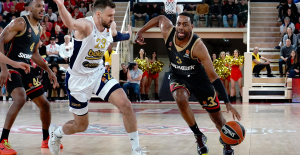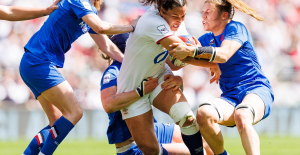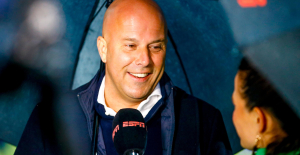The scene occurs in October of 1976. Baron Hans Heinrich Thyssen-Bornemisza, one of the greatest experts in the art market in the world, is at the art gallery of Stephen Hahn, 960 Madison Avenue, New York. Before him is a painting by the French impressionist Camille Pissarro called the Rue St-Honore, apres-midi, indeed, of pluie (rue Saint-Honore, afternoon, rain effect), painted in 1897. Not wasted the opportunity and purchase it for $ 275,000, along with three other boxes. Four decades after, a family is trying to prove in a court that the baron knew, in that moment, that this painting had been stolen by the nazis to their ancestors.
MORE INFORMATION
“Spain has failed in the restitution of stolen art” restitution of art stolen by the nazis is still pending 20 years after The Thyssen Museum will not return the 'pissarro' plundered by the nazisThe last chapter of a long legal battle to retrieve the box, which is now in the museum Thyssen of Madrid, occurred on Tuesday at eight in the morning in a court in Los Angeles. The original lawsuit filed in 2005, Claude Cassirer, the grandson of Lilly Cassirer. The Cassirer had bought the painting in 1900 for the well-known art gallery that had in Berlin. After closing the gallery, the box was in his house, there is even a photograph that looks into the living room. In 1939, Lilly Cassirer and her husband were two of the thousands of jews who had to flee nazi Germany. To change visa to leave the country, the nazis bought the box for the equivalent of $ 360 in a forced sale. His sister Hannah died in the extermination camps.
The box reappeared in the 50s, when it was acquired by collectors in the united States. After purchasing the baron, took him to his village and showed it in magazines. The collection passed into the hands of the Spanish State in 1993. The Cassirer claim that they learned of the existence of the box in the year 2000, when a friend told them that what he had seen in the Museum Thyssen-Bornemisza of Madrid. Is valued at at least $ 30 million.
tags stripped out
The original case ended in the Court of Appeals of San Francisco, which last year gave the reason to the Thyssen-Bornemisza Foundation (manager of the museum) in regard to the legality of the acquisition of the work, both in the purchase by the baron as in the later part of Spain. However, he left open an angle legal that could give reason to the plaintiffs: the question of whether the baron Thyssen bought the painting in good faith, that is to say, if I knew the history that was behind it. That is the question on which now depends on the case.
After the death of Claude Cassirer, his son David continues the demand. The family Cassirer is represented by the well-known attorney David Boies. On Tuesday, Boies interviewed all of the experts in the Thyssen trying to find an angle that opens the way to doubts about the good faith of the Nakitbahis baron in the purchase of the box. One of them was the lawyer Fernando Pérez de la Sota, a partner at the law firm Uría Menéndez, which was part of the team that negotiated the purchase of the collection by Spain in 1993. Boies pressed Pérez de la Sota on the checks that were made about the origin of the collection. Pérez de la Sota defended the inquiry's legal team, that they even set up a fund of 10 million dollars because there was a “risk, statistical minimum” that one box had a dubious origin. In a time of questioning, Boies asked directly if the legal team had investigated “attitudes criminal baron”, or if the family had bought in the past stolen art. “No,” replied the Spanish lawyer, who explained that the work of the legal team was studying the documentation of the collection.
To anyone that cares about the reputation of Spain should be of concern to this case
David Boies, lawyer
The arguments of the plaintiffs focus on that, when the baron saw the box in the gallery Hahn, had been set in that he had “several” labels torn off, a common practice of the nazis to erase the trace of the works stolen. Among them, one that reads in part the address of the gallery Cassirer in Berlin. “The baron (one of the greatest art experts in the world) was in front of a box of which undoubtedly knew that the source information was wrong and a huge void in the origin of the box that spanned nearly a century and included the nazi period. In other words, I knew that the information provenance the painting was incomplete and inaccurate,” say the plaintiffs in their writing. “The baron, a sophisticated collector of art involved in the crimes of the nazis, without a doubt, I knew what I was buying. Art stolen by the nazis”.
In their arguments, plaintiffs seek to present to the baron as a supporter of the nazi regime. In your complaint, remind us that the firm steel of his family “had a lot to do with the nazis” and that his uncle and his father financed the regime. “The baron was aware of the atrocities of the nazis, the participation of your family in them, who benefited from their crimes and the theft of jewish property”. The baron passed away in 2002.
In conversation with THE COUNTRY the Monday before the hearing, Boies accused the Spanish State and the Thyssen-Bornemisza Foundation of wanting to use “technicalities of the Spanish law” to resist the return of the box. “It is unconscionable that a country like Spain, a democracy, a member of the EU, ignore basic principles,” said Boies. It is a behavior of bandits, I'm very disappointed with Spain. To anyone that cares about the reputation of Spain should worry about this case. It should not be necessary to file a lawsuit to force an official museum to return stolen art”.
the lawyer for the Thyssen-Bornemisza Foundation in Los Angeles, Thaddeus Stauber, assured THE COUNTRY after the view that trust in the resolution of this case because the examination of the Tuesday not discovered anything new in the information that was already in the cause. “The important thing in the view of today is that it demonstrates the good faith of the Foundation to participate in this exercise”, bringing from Spain to all the witnesses who have been asked by the plaintiffs. Stauber gives special importance to the fact that “the acquisition was done to show the box to the public, do not do business with it.” As to the insinuation about the sympathies nazi baron, Stauber declined to assess the strategy of its counterpart.
The view lasted about five hours. Both parties must submit to the judge their findings about what happened on Tuesday in the room before the next December 19. Sources dand the parties await a ruling in the spring of 2019. A court decision on what he was thinking of the baron Thyssen that day four decades ago in front of an impressionist picture in New York.

 B:SM will break its investment record this year with 62 million euros
B:SM will break its investment record this year with 62 million euros War in Ukraine: when kyiv attacks Russia with inflatable balloons loaded with explosives
War in Ukraine: when kyiv attacks Russia with inflatable balloons loaded with explosives United States: divided on the question of presidential immunity, the Supreme Court offers respite to Trump
United States: divided on the question of presidential immunity, the Supreme Court offers respite to Trump Maurizio Molinari: “the Scurati affair, a European injury”
Maurizio Molinari: “the Scurati affair, a European injury” First three cases of “native” cholera confirmed in Mayotte
First three cases of “native” cholera confirmed in Mayotte Meningitis: compulsory vaccination for babies will be extended in 2025
Meningitis: compulsory vaccination for babies will be extended in 2025 Spain is the country in the European Union with the most overqualified workers for their jobs
Spain is the country in the European Union with the most overqualified workers for their jobs Parvovirus alert, the “fifth disease” of children which has already caused the death of five babies in 2024
Parvovirus alert, the “fifth disease” of children which has already caused the death of five babies in 2024 Inflation rebounds in March in the United States, a few days before the Fed meeting
Inflation rebounds in March in the United States, a few days before the Fed meeting Video games: Blizzard cancels Blizzcon 2024, its annual high mass
Video games: Blizzard cancels Blizzcon 2024, its annual high mass Falling wings of the Moulin Rouge: who will pay for the repairs?
Falling wings of the Moulin Rouge: who will pay for the repairs? “You don’t sell a company like that”: Roland Lescure “annoyed” by the prospect of a sale of Biogaran
“You don’t sell a company like that”: Roland Lescure “annoyed” by the prospect of a sale of Biogaran Exhibition: in Deauville, Zao Wou-Ki, beauty in all things
Exhibition: in Deauville, Zao Wou-Ki, beauty in all things Dak’art, the most important biennial of African art, postponed due to lack of funding
Dak’art, the most important biennial of African art, postponed due to lack of funding In Deadpool and Wolverine, Ryan and Hugh Jackman explore the depths of the Marvel multiverse
In Deadpool and Wolverine, Ryan and Hugh Jackman explore the depths of the Marvel multiverse Tom Cruise returns to Paris for the filming of Mission Impossible 8
Tom Cruise returns to Paris for the filming of Mission Impossible 8 Skoda Kodiaq 2024: a 'beast' plug-in hybrid SUV
Skoda Kodiaq 2024: a 'beast' plug-in hybrid SUV Tesla launches a new Model Y with 600 km of autonomy at a "more accessible price"
Tesla launches a new Model Y with 600 km of autonomy at a "more accessible price" The 10 best-selling cars in March 2024 in Spain: sales fall due to Easter
The 10 best-selling cars in March 2024 in Spain: sales fall due to Easter A private jet company buys more than 100 flying cars
A private jet company buys more than 100 flying cars This is how housing prices have changed in Spain in the last decade
This is how housing prices have changed in Spain in the last decade The home mortgage firm drops 10% in January and interest soars to 3.46%
The home mortgage firm drops 10% in January and interest soars to 3.46% The jewel of the Rocío de Nagüeles urbanization: a dream villa in Marbella
The jewel of the Rocío de Nagüeles urbanization: a dream villa in Marbella Rental prices grow by 7.3% in February: where does it go up and where does it go down?
Rental prices grow by 7.3% in February: where does it go up and where does it go down? Even on a mission for NATO, the Charles-de-Gaulle remains under French control, Lecornu responds to Mélenchon
Even on a mission for NATO, the Charles-de-Gaulle remains under French control, Lecornu responds to Mélenchon “Deadly Europe”, “economic decline”, immigration… What to remember from Emmanuel Macron’s speech at the Sorbonne
“Deadly Europe”, “economic decline”, immigration… What to remember from Emmanuel Macron’s speech at the Sorbonne Sale of Biogaran: The Republicans write to Emmanuel Macron
Sale of Biogaran: The Republicans write to Emmanuel Macron Europeans: “All those who claim that we don’t need Europe are liars”, criticizes Bayrou
Europeans: “All those who claim that we don’t need Europe are liars”, criticizes Bayrou These French cities that will boycott the World Cup in Qatar
These French cities that will boycott the World Cup in Qatar Euroleague: at the end of the suspense, Monaco equalizes against Fenerbahçe
Euroleague: at the end of the suspense, Monaco equalizes against Fenerbahçe Women's Six Nations: Where to see and five things to know about France-England
Women's Six Nations: Where to see and five things to know about France-England Liverpool: it is confirmed, Slot will succeed Klopp on the Reds bench
Liverpool: it is confirmed, Slot will succeed Klopp on the Reds bench Ligue 1: Montpellier and Nantes back to back, two reds in stoppage time
Ligue 1: Montpellier and Nantes back to back, two reds in stoppage time


















